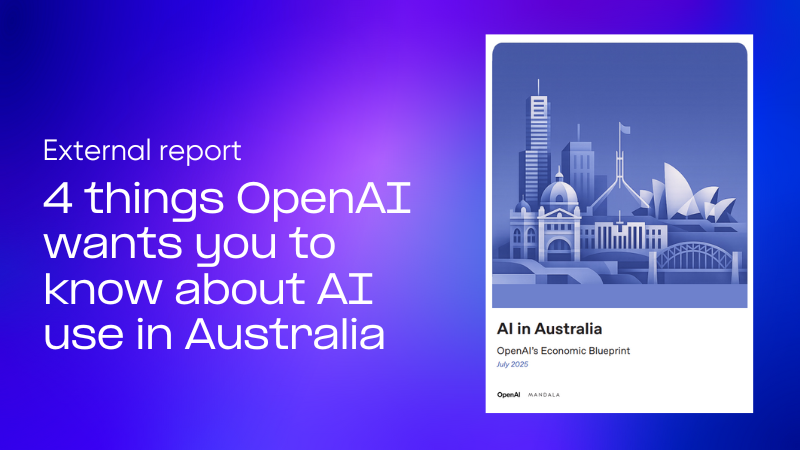
4 things OpenAI wants you to know about AI in Australia
OpenAI just released a report titled "AI in Australia—OpenAI’s Economic Blueprint" mapping how AI could reshape Australia’s economy, and they’re calling for bold, coordinated action.
Partnering with Mandala Partners, OpenAI’s AI Economic Blueprint outlines how AI could deliver $115 billion in annual value by 2030, mostly by boosting productivity. But OpenAI is clear: Australia needs to act now to stay globally competitive.
Here are four things OpenAI tech professionals and future ICT workers should know:

1. AI is your productivity edge, but only if you’re ready to use it
Australia’s productivity has stagnated, with output per hour worked now 18% lower than in the US. According to OpenAI, AI can help turn that around, not by replacing jobs, but by enhancing human capability.
For you, that means opportunities to:
Automate admin and routine workflows
Build or integrate custom AI tools
Focus on strategy, creativity, and problem-solving
OpenAI cites use cases from healthcare to education where AI is already enhancing performance, and argues the next leap forward depends on wide-scale adoption.
2. AI skills can’t be an afterthought, training is key
OpenAI warns that Australia isn’t moving fast enough on AI capability. They’re urging national investment in AI skills from primary school through to workforce training.
Their 10-point plan includes:
Micro-credentials and enterprise upskilling programs
AI literacy in school and university curricula
Sector-based frameworks and faster development of national standards
Whether you're a student, developer, team leader, or CTO, staying ahead will require continuous learning, particularly in areas like AI integration, ethics, governance, and tool development.
The research in ACS Digital Pulse 2025, which will launch on 30 July, has also identified the importance of continuous learning, citing that 70% of job-related skills will change by the end of the decade.
3. Australia could become a regional AI leader, if we build the infrastructure
OpenAI highlights Australia’s potential to become the Indo-Pacific’s trusted AI hub, thanks to our stable governance, renewable energy, and land availability. But they point out the need to invest to grow capacity, for example, in:
Data centres and sovereign compute capacity
Affordable, renewable energy for AI workloads
AI-specific infrastructure approvals and funding incentives
OpenAI estimates the data centre expansion alone could create 8,000+ new tech jobs in cloud engineering, DevOps, cybersecurity, and infrastructure design by 2030.
4. AI is here to support people, not just automate processes
One of OpenAI’s key messages is that AI shouldn’t be about cutting corners; it should be about amplifying human work. Their blueprint promotes AI that frees up time for:
Teachers to focus on students, not admin
Healthcare workers to spend more time with patients
Public servants to improve citizen services
For you, this signals strong future demand in AI ethics, public sector innovation, and digital accessibility, as well as roles focused on deploying AI responsibly.
Opportunities for ACS members
Whether you’re an engineer, developer, public sector technologist or entrepreneur, the OpenAI blueprint reinforces the critical role of tech professionals in:
Shaping responsible AI: From governance to deployment, technologists must lead the charge in making AI ethical, secure and inclusive.
Boosting productivity and innovation: The professionals who adopt continuous learning to upskill and stay relevant will remain productive and highly employable.
Strengthening national resilience: AI is central to cybersecurity, public trust, and digital sovereignty. Your work underpins national security.
